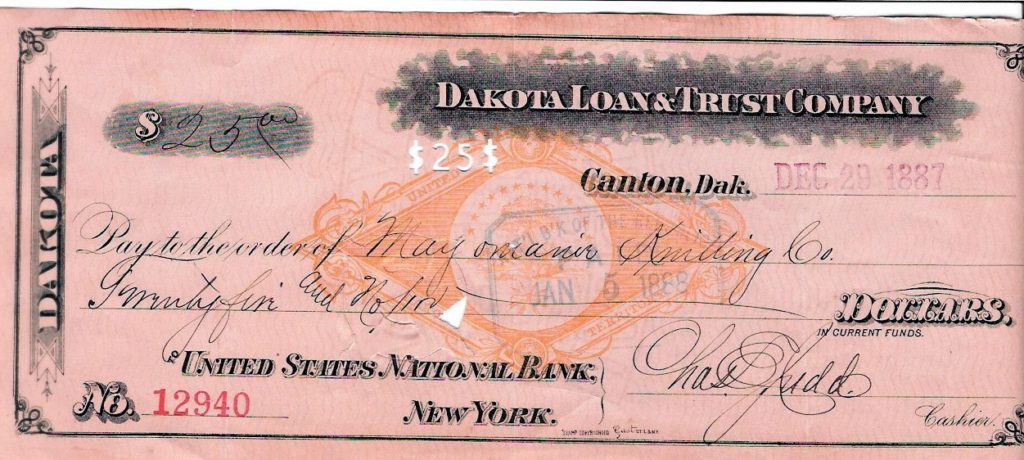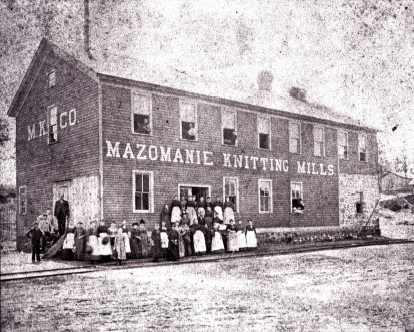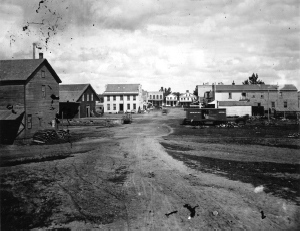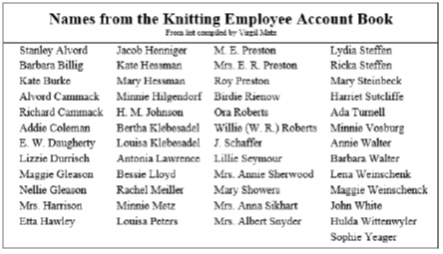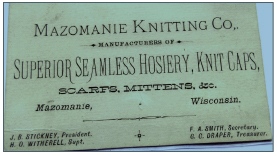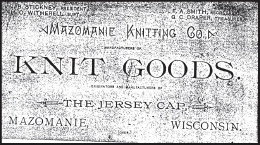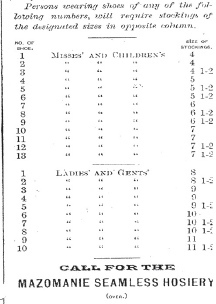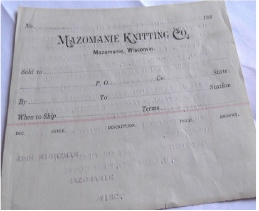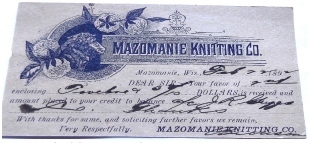This story was written by Phyllis Calkins in 2017 for the Mazomanie Historical Society.
Have you ever come across something that you had lost or forgotten?? …an old photograph, letter or maybe an old coin… and, did you wonder about the lives of the people who lived there at that time? Well, it happened to me last fall while I was going through a box in my basement.
The box contained a letter postmarked September 24,1974 and was from R.C. Bakewell in Sioux Falls, S.D. The envelope was addressed to H.N. Schoenmann, Peoples State Bank, Mazomanie, WI and contained an old check from the Dakota Loan and Trust Company, Canton Dakota. The check dated December 29, 1887, was made payable to the Mazomanie Knitting Company in the amount of $25.00.
Shortly after finding this historic check, I contacted our Mazomanie Historical Society curator, Rita Frakes, and the search began… Rita’s files contained photos, maps, an employee ledger, advertising literature, employee names and company records which had been compiled by Jean Mahoney from old issues of the Mazomanie Sickle.
History of the Mazomanie Knitting Company 1882 – 1892
The Mazomanie Knitting Company leased the factory of N. Kirch and purchased the warehouse and engine of Messrs. Huggins & Wendt on December 1882. They soon reconstructed the interior into apartments suitable for the manufacture of knitted goods. The business started on a moderate basis with the expectation of increasing the capacity of the factory that would prove to be the starting of a manufacturing enterprise that eventually would be of great benefit to the village. For the first few weeks, about a dozen people were employed, but soon 50 or 60 people were working in the factory and later, many more were hired for finishing work.
The Capital Stock in 1882 was $25,000 and payroll ranged from $1,000 to $3,000 per month. December 1885 Statements from the Knitting Company showed:
Real Estate and Machinery value = $10,000 Stock Value = $15,000
Men Employed 15
Women Employed 60
Wages during 1885 $14,000 – $15,000
Value of knit goods in 1 year $50,000 – $60,000
In 1886 the Capitol Stock increased from $20,000 to $30,000.
The building on the left was a grain warehouse built by L.A. Lincoln in 1856 before it became the Mazomanie Knitting Factory. The Mazomanie Knitting Company was organized in 1882 by Bronson, Draper & Co., Murrish & Sons, Smith and Campbell, J.B. Stickney, J.A. Schmitz, F. Heydecke, and Henry Fisher. Samuel Murrish was elected President, but resigned after a few years and was succeeded by J.B. Stickney.

This 1886 map shows the location of the knitting company in Mazomanie. Brodhead Street looking north, L.A. Lincoln Grain Warehouse 1856-1882; Knitting Factory, 1882 – 1892.
Employees
The company advertised and promised steady employment. For the first few weeks, only about a dozen people were employed. August, 1883 — the company is continually enlarging the number of employees, now giving employment to 49 in the factory and nearly 60 closers (who worked at the end of the line).
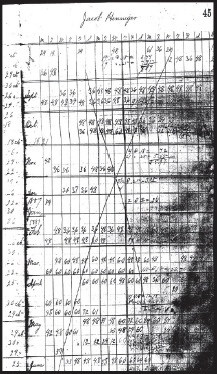
This is one of the pages from the Employee Account Ledger showing the time sheet for Jacob Henniger. On March 29, 1883 Jacob accomplished the best day’s work that had yet been done — he knit 40 pairs of socks.
Once the sock was taken off the machine, closers finished the sock by closing the seam for the heel and closing the seam for the toe. This was done by hand, sewing with needle and yarn. After each item was finished to perfection, it was inspected before being shipped.
Salesmen were an important link in the success of the business
Fred Bronson traveled for the company, promoting the company’s products. Covering his route often took 2 or more months. On February 4, 1891, Frank Roberts returned from his initial trip in the northern part of the state. His first experience met with encouraging success. H.O. Witherell frequently traveled thru northern Minnesota and Illinois to purchase equipment for the business.
Fun & Games
Employees not only enjoyed vacations; they also had baseball games to look forward to. On June 23, 1890, a match game was held between the Milling and Knitting companies. The weather was hot and the game resulted in favor of the Knitting Works by a score of 27-15. The entire group from the knitting factory participated in a day’s outing at Fish Lake and later that month they indulged in another day of recreation and rest at Fish Lake. Also, during that summer the Knitting and Citizens baseball teams crossed bats twice. “On a Monday morning the Citizens done them in to the tune of 16 to 6. On Friday of that week, the Knitters pulled wool over the eyes of the Citizens and then ran in 21 scores while the poor fellows got only 19.”
Products
The knitting factory rapidly put on a business appearance by turning out knit hosiery, mittens, underwear, scarves, gloves and caps. In May 1884, they announced they were making a woolen cap that took off like wild fire. It was called the “Jersey cap” and is one of the neatest and warmest caps that’s ever been put on the market. The “J.I.C.” cap was something that carried off the laurels for winter wear and the demand for this article alone was immense after it was thoroughly introduced.
The Mazomanie Knitting Company promoted their knit goods and the Jersey Cap. In August they received an order from a New York firm for 200 dozen caps. Other large orders were received from firms in Boston. and they also received an order from a New York firm for 200 dozen caps the following year. Little information about the Jersey Cap was found on the internet. The 1958 Americana Funk & Wagnalls Standard Dictionary International edition p.685 noted only the following: “a plain knitted, elastic, ribbed fabric of wool, cotton, rayon etc. fine woolen yarn of fine combed wool as spun in the island of Jersey.”
The knitting company, in common with other industries, had a prosperous trade this season. There was a test of knitted goods at the factory, which proved that Mazo’s goods were ahead of Madison, Rockford and other’s work. Orders were showering in faster than ever before. Many parties who sent in orders were so pleased with the merchandise that they duplicated their orders to be ready for the increasing demand for them.
On Thursday of last, they made a shipment of $2,000 worth of goods, being the largest single day’s shipment ever made by them. In October, 1885, in order to supply the demand for goods, the company commenced to work during the fore part of the night. A special order was completed December 1, 1888 for underwear for a man living in Spokane Falls, Washington. His gigantic proportions astonished everyone who had seen the garments. His measurement at the chest was 55”, abdomen 64”, waist 56”, hips 62”, thigh 33, and calf 22-1/2”. If his height was in proportion with his measurements, he would have been over 8 foot tall.
This handy little chart was given to customers to help determine the correct size of stockings to purchase. Persons wearing shoes of any of the following numbers, will require stockings of the designated sizes in opposite column.
How Knitting Was Done
In March of 1874, S.E. Bronson began publication of the Sickle. He gave readers this insight on how knitting was done at the Mazomanie Knitting Company. “Last week we took it upon ourselves the difficult task of explaining to our readers the operations through which yarn must go to become knitted goods. We went today to find this out and upon arriving at the factory we were confronted by a sign on the door inscribed “Positively no admittance”. Having never learned the alphabet, we pretended to be ignorant of its meaning and bolted right in.”
“Mr. Witherell kindly showed us the intricate working of the complicated machinery. First, the great pressure that could be attained with the steam press, with which the goods were pressed into shape. Second, the mysteries of the smooth-running bobbin-winder, upon which he made a patent that greatly facilitates the winding of yarn in appropriate shape upon the bobbin and for which he received a remuneration of $200. Then we were taken up the winding stair to the knitting room where we saw the operators industriously at work performing the duties involved in running the machines. The knitting machine in itself does not resemble in the least a threshing machine, as our imagination first led us to believe, but is a little complicated contrivance, composed of a cylinder with needles attached in such a way as to form a circle, around which it swiftly carried the thread, and striking the needles at a given point, in which they were sunk, catching the thread and making a loop stitch. Feeling fully repaid for our timely visit, we took our departure with the firm conviction that we knew more about knitting now than at any other period of our life.”
Equipment
New equipment and updates were necessary to keep everything running smoothly. In March 1883 the addition of a large wood shed was made to hold the 40 cords of wood which was purchased for $2.75 a cord. Machines received were one press, one winding machine and 10 knitting machines. On May 24, 1884 a new sign, “Mazomanie Knitting Mills” graced the front side and full length of the building. It was executed by John Knapp and reflected credit to his established reputation as a sign painter. Over the next couple of years, a new boiler was purchased for the factory replacing the one that was being used, but damaged by the many years of service as to be incapable of performing the work. Mr. Witherell traveled to Chicago to procure an iron lathe and tools to enlarged our capacity to 30 machines. He made application for a patent for an improvement of knitting machines, which added greatly to the accurate and speedy measurement of the knit goods.
In January of 1886 the company engaged in laying steam pipe that would heat the factory with the exhaust steam of the engine. A new 16×16 dry room was completed in 1888 and fitted up with steam heating apparatus. The room could be heated to 130 degrees, so hot that a grease spot would boil up like a formidable geyser.
During the coming year more improvements were in machinery and in the house, to further enable them to manufacture a superior class of goods on which they built an excellent reputation and for such the demand is ever increasing.
The Mills Bill of 1888
Roger Quarles Mills was a United States lawyer and politician. During the American Civil War he served as an officer in the Confederate States Army. Afterwards he served in the United States Congress, first as a Representative and later as a Senator. He introduced the Mills Bill of 1888 and if it had passed, it would have seriously damaged the success of the Mazomanie Knitting Company and all other similar businesses. The Mills Bill passed the House, a Republican Senate amended it heavily, but it never passed into law.
What effect the Mills Bill would have on the hosiery business
In an announcement, S.E. Bronson, explained the damage that would be done by this Bill.
“The knitting factory started with several objectives in mind…” First, they hoped to realize for themselves more than the common rate of interest for the money invested; second, they wished to furnish employment to labor and thereby improve business and increase the general prosperity of our town. The only cash returns that the stockholders ever realized have been on the basis of 5% on invested capitol. It isn’t enough. But everyone will admit that the stockholders have not any dividends that they can afford to divide up with the owners of the knitting factories in Germany and England. The Democratic party proposed that we divide our little profits with foreign countries or reduce the wages of the employees; or increase the amount of foreign importations — all of which amounts to the same thing.”
“That this factory is a general benefit to the community will be conceded on all sides. The stockholders, the employees and the community have a mutual interest in its welfare. If it can be proven that Cleveland and Mills, for the sake of getting cheaper stockings for the buyer, are going to do us a great injury, when we are engaged in a legitimate business and realizing only small profits, then it is our duty to do what little we may, by vote and influence to prevent the accomplishment of their object.”
“If a merchant asks his clerk to help him in fighting his enemy, it is all right, but if a manufacturer undertakes, in a fair and open manner, to convince his employees that they should oppose a politician the false cry is raised on “intimidation”.
Let’s see what effect the Mills Bill would have on the hosiery business
Bronson explains: “It repeals the duty on wool. The present duty on scoured wool is 16¢ a pound for the grade used in fine hosiery,– the London value being 46¢ and the Boston value 62¢ per pound. It takes 20 ounces of this scoured wool to make 16 ounces of yarn. The reduction on yarn then would amount to 20¢ a pound.”
“This factory always has on hand, either in yarn or finished goods, about 12,000 pounds of Stock. Hence, if the Mills Bill becomes law, our little factory would suffer an immediate loss, in the value of stock on hand of $2,400, which represents more than 2 years earnings of the stockholders.”
“Merchants all over the country would suffer a corresponding loss on their woolen goods of every description, and hundreds of them would be driven into bankruptcy. And what good would the Democratic accomplish by it? They would reduce the cost of woolen hosiery to the consumer exactly 5¢ a pair, and other woolen goods in proportion.” But the Mills Bill doesn’t stop there…”
“The present duty on woolen hosiery is 35¢ a pound and 40 percent ad valorem on top of that. In spite of this high duty, England alone now sends to this country $1,159,000 worth of hosiery yearly. The grade of hosiery imported is valued at $1 a pound in London. The Mills Bill proposes to wipe out the 35¢ a pound duty and keep the 40 percent, ad valorem only, and claims that we do not need the 35¢ a pound duty because we get wool free under that bill.”
Let’s see how it works out –
As Branson said, “The repeal of the duty on wool cheapens the scoured article 16¢ a pound which amounts to 20¢ a pound when converted into yarn. Now stands the result:
Loss to American Factory 35¢
Gain on full wool 20¢
Net loss 15¢
It takes 3 pounds for a dozen pair of stockings which makes a total loss of 45¢ a dozen on all hosiery made after the Mills Bill becomes a law, besides making it just so much easier for European manufacturers to flood this country with their goods and ruin our trade. The long and short of it is that the Mills Bill would wipe out the little profit the stockholders get out of this business or necessitate reduction in wages.” (The Mills Bill passed the House, a Republican Senate amended it heavily, and it never passed into law.)
June 27, 1891
A thunderbolt from a clear sky could not have caused a greater surprise in this community than did the announcement that the Mazomanie Milling Company and Bronson, Draper & Co. bankers, were obliged to suspend business from financial embarrassment. The two firms had been closely connected in their business relations and the banking firm being the principal stockholders in the mill. In addition to the mill, Bronson, Draper & Co. owned 31 shares of stock of one hundred dollars each in the knitting company. It appears that this stock had to be sold which resulted in the knitting factory being purchased by a Mankato, Minnesota firm. Mazomanie suffered one more loss in the purchase of the knitting factory by J.A. & M.S. Willard of Mankato, Minnesota. On March 19, 1892 the knitting company’s machinery was also shipped to the new location. They intended to put in new machinery with the old, and establish the factory in that place. Several employees were retained by the new company, including Fred Bronson who left Mazomanie on April 28th, 1892. Also during 1892, the village bought the building for a powerhouse and firehouse. A Bell Tower was added in 1894 and sadly, the building burned down in 1900, which was the end of an era for the Mazomanie Knitting Company.


